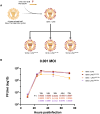Effect of pandemic influenza A virus PB1 genes of avian origin on viral RNA polymerase activity and pathogenicity
- PMID: 39671482
- PMCID: PMC11641000
- DOI: 10.1126/sciadv.ads5735
Effect of pandemic influenza A virus PB1 genes of avian origin on viral RNA polymerase activity and pathogenicity
Abstract
Zoonotic influenza A virus (IAV) infections pose a substantial threat to global health. The influenza RNA-dependent RNA polymerase (RdRp) comprises the PB2, PB1, and PA proteins. Of the last four pandemic IAVs, three featured avian-origin PB1 genes. Prior research linked these avian PB1 genes to increased viral fitness when reassorted with human IAV genes. This study evaluated chimeric RdRps with PB1 genes from the 1918, 1957, and 1968 pandemic IAVs in a low pathogenic avian influenza (LPAI) virus background to assess polymerase activity and pathogenicity. Substituting in the pandemic PB1 genes reduced polymerase activity, virulence, and altered lung pathology, while the native LPAI PB1 showed the highest pathogenicity and polymerase activity. The native LPAI PB1 virus caused severe pneumonia and high early viral RNA levels, correlating with elevated host cytokine signaling. Increased genetic distance from the LPAI PB1 sequence correlated with reduced polymerase activity, IFN-β expression, viral replication, and pathogenicity.
Figures




References
-
- Taubenberger J. K., Reid A. H., Lourens R. M., Wang R., Jin G., Fanning T. G., Characterization of the 1918 influenza virus polymerase genes. Nature 437, 889–893 (2005). - PubMed
-
- Patrono L. V., Vrancken B., Budt M., Düx A., Lequime S., Boral S., Gilbert M. T. P., Gogarten J. F., Hoffmann L., Horst D., Merkel K., Morens D., Prepoint B., Schlotterbeck J., Schuenemann V. J., Suchard M. A., Taubenberger J. K., Tenkhoff L., Urban C., Widulin N., Winter E., Worobey M., Schnalke T., Wolff T., Lemey P., Calvignac-Spencer S., Archival influenza virus genomes from Europe reveal genomic variability during the 1918 pandemic. Nat. Commun. 13, 2314 (2022). - PMC - PubMed
MeSH terms
Substances
LinkOut - more resources
Full Text Sources
Research Materials
Miscellaneous

